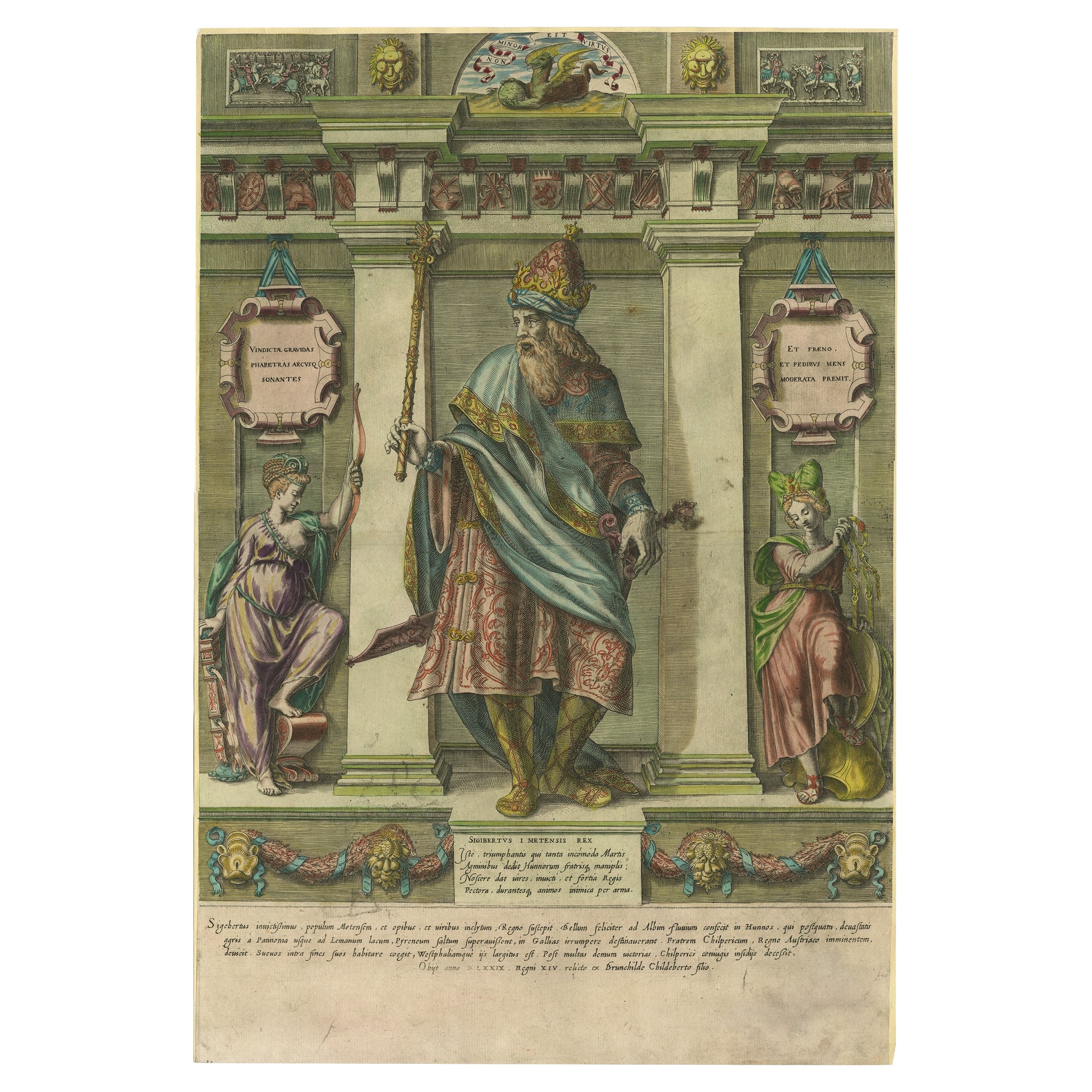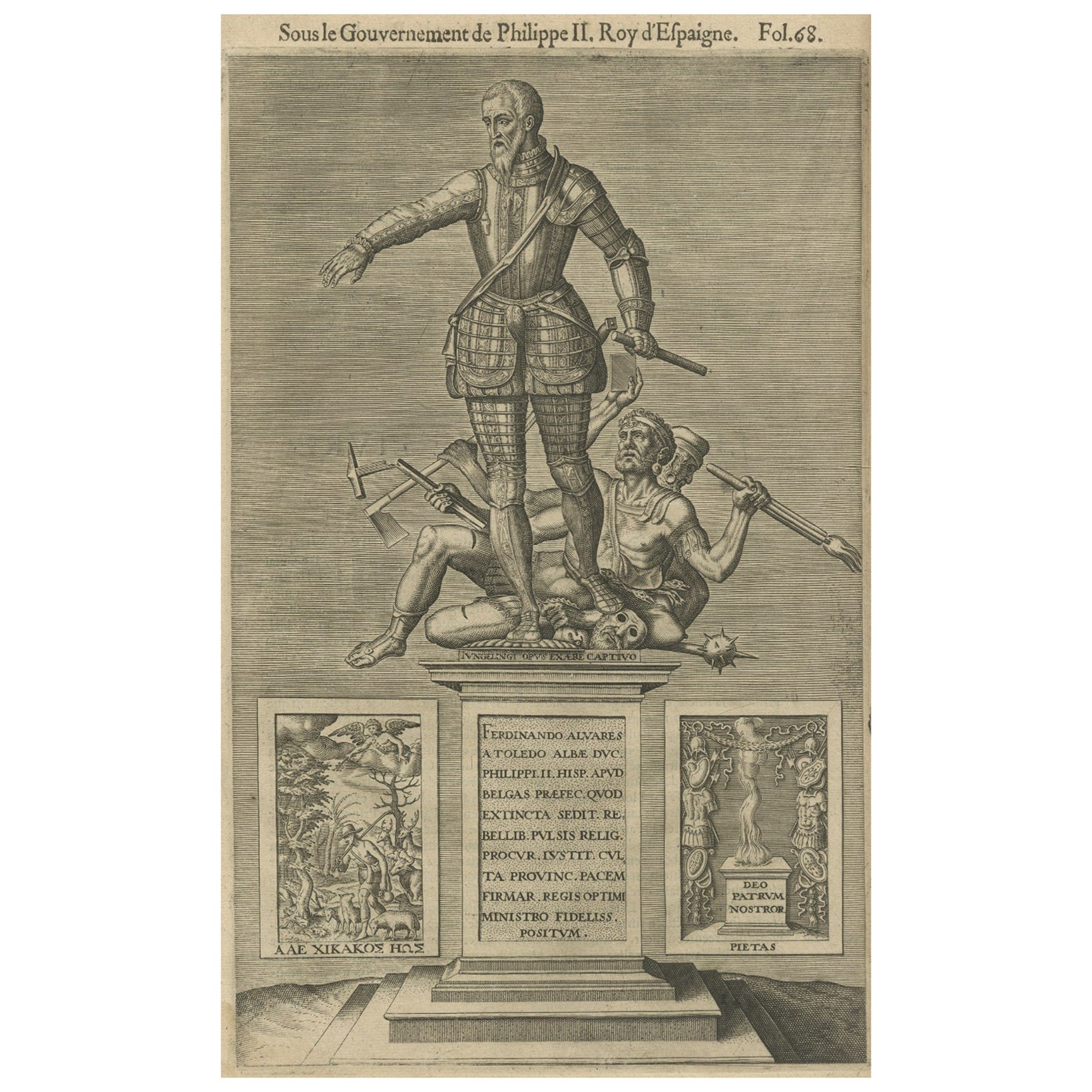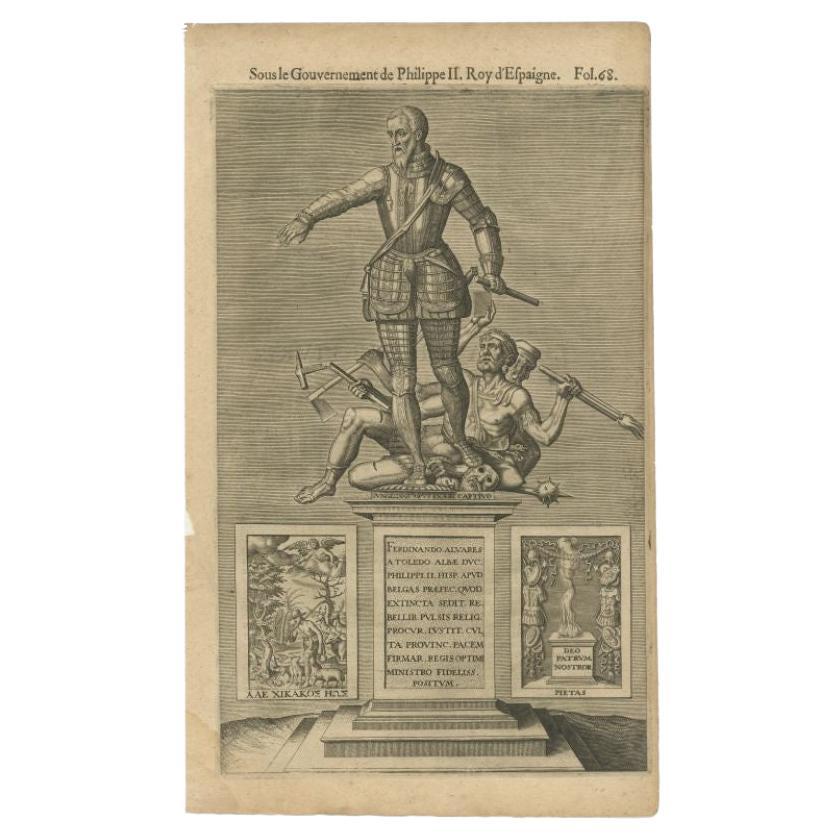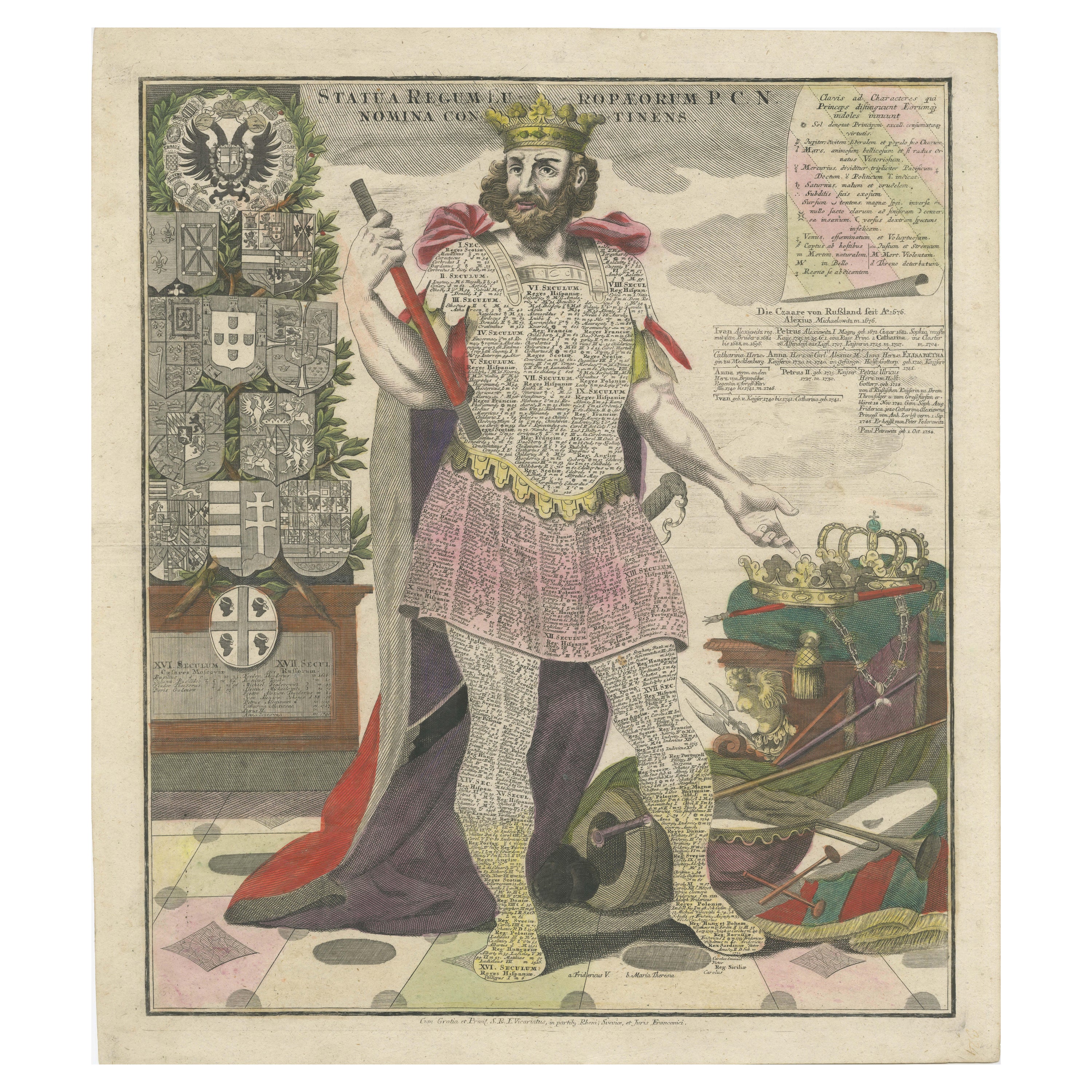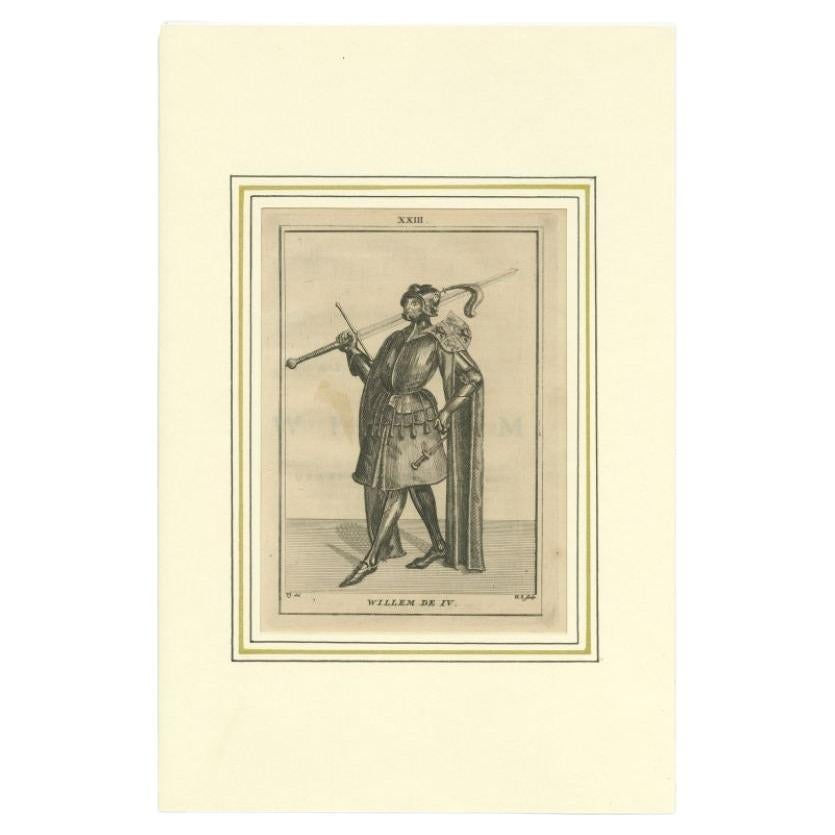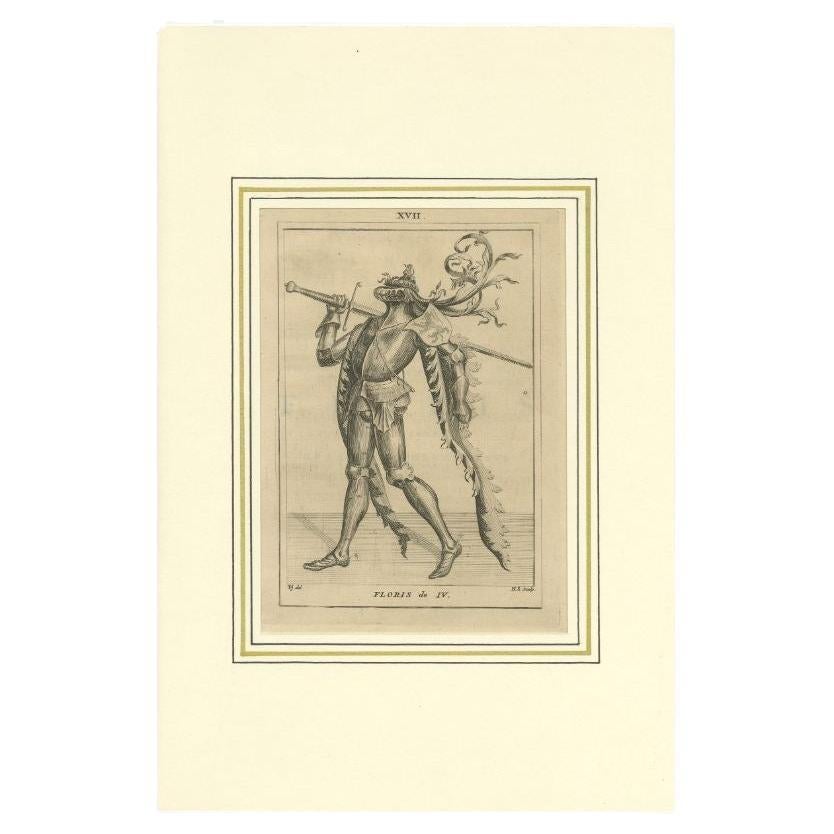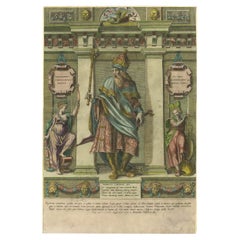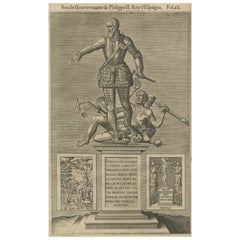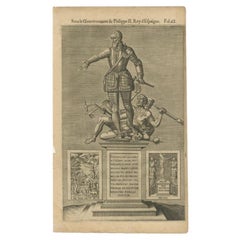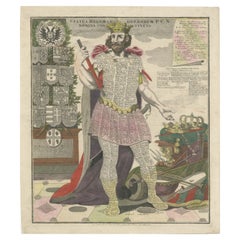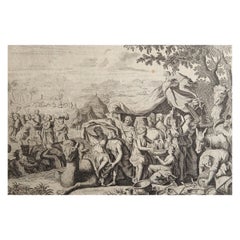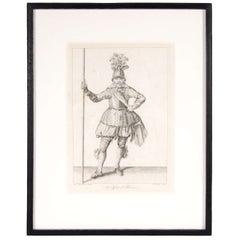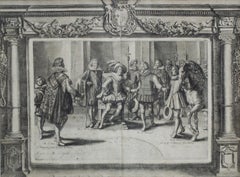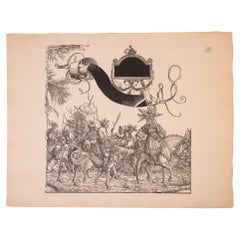Items Similar to Ernest the Iron of Austria - Antique Engraving by Gaspar Oselli, 1569
Want more images or videos?
Request additional images or videos from the seller
1 of 6
Ernest the Iron of Austria - Antique Engraving by Gaspar Oselli, 1569
$948.93
$1,186.1620% Off
£706.42
£883.0220% Off
€792
€99020% Off
CA$1,299.80
CA$1,624.7520% Off
A$1,445.66
A$1,807.0720% Off
CHF 754.88
CHF 943.6020% Off
MX$17,592.11
MX$21,990.1420% Off
NOK 9,640.94
NOK 12,051.1720% Off
SEK 9,041.50
SEK 11,301.8720% Off
DKK 6,029.22
DKK 7,536.5220% Off
Shipping
Retrieving quote...The 1stDibs Promise:
Authenticity Guarantee,
Money-Back Guarantee,
24-Hour Cancellation
About the Item
Antique print titled ''Ernestus Ferreus Arch'.
**Ernest the Iron (1377-1424)**
Background: Ernest the Iron, also known as Ernst der Eiserne, was a member of the House of Habsburg. He ruled over the duchies of Styria, Carinthia, and Carniola, which are regions in present-day Austria and Slovenia.
Reign: Ernest became the head of the Leopoldian line of the Habsburgs in 1411. His rule was marked by efforts to consolidate Habsburg power in the region.
Significance: His nickname, "the Iron," likely refers to his steadfastness and strong leadership during turbulent times. His reign laid the groundwork for the future prominence of the Habsburg dynasty in European politics.
Artistic Techniques
Engraving
- **Medium**: The print is a copperplate engraving, a common technique during the Renaissance for producing detailed and precise images. Engravers would incise lines into a metal plate, ink the plate, and then press it onto paper to create the print.
- **Detail**: This print shows meticulous attention to detail, especially in the depiction of Ernest’s armor and the surrounding architectural elements. The textures and patterns on the armor are carefully rendered to give a sense of depth and realism.
- **Coloring**: The print is hand-colored, which was a common practice to enhance the visual appeal of black-and-white engravings. The colors are likely added with watercolor paints, giving a vibrant and dynamic look to the image.
**Symbolism and Composition**
- **Architectural Elements**: The background features classical architectural elements such as columns, arches, and a frieze. These elements frame the central figure of Ernest and lend a sense of grandeur and importance to the subject.
- **Allegorical Figures**: The print includes allegorical figures, likely representing virtues or aspects of Ernest’s reign. For example, the figure on the left with wings and a wheel might represent Fortuna (Fortune), indicating Ernest's successful and fortunate rule.
- **Latin Inscriptions**: The inscriptions provide context and celebrate Ernest’s achievements. These were typical in Renaissance portraiture to convey the subject's virtues and historical significance.
Significance within the Collection
**Austriacae Gentis Imagines**
- **Collection**: This print is part of "Austriacae Gentis Imagines," a collection of portraits of notable figures from the Habsburg dynasty and Austrian nobility, compiled by Francesco Terzi.
- **Purpose**: The collection aimed to celebrate and document the lineage and achievements of the Habsburg family. Such collections were important for reinforcing dynastic legitimacy and prestige.
- **Engraver’s Role**: Gaspar Oselli, the engraver, played a crucial role in visually interpreting and preserving these historical figures. His works contributed to the dissemination of Habsburg imagery and propaganda.
**Gaspar Oselli (1536-1577)**
- **Style and Influence**: Oselli was known for his detailed and precise engraving style. Although many of his works were copies of other engravers, his ability to reproduce intricate details ensured the high quality of the prints in Terzi's collection.
- **Legacy**: Oselli’s engravings remain valuable historical documents, providing insight into the artistic and cultural practices of the Renaissance period.
Conclusion
This antique print of Ernestus Ferreus by Gaspar Oselli is not only a fine example of Renaissance engraving but also a significant historical artifact. It offers a glimpse into the art and politics of the time, highlighting the importance of visual culture in shaping and preserving the legacy of powerful dynasties like the Habsburgs. The combination of detailed artistry, rich symbolism, and historical context makes this print a valuable piece for both art historians and those interested in European history.
Artists and Engravers: Gaspare Oselli, Gaspare ab Avibus, Gaspar Patavinus (1536 - 1577). Engraver; half-brother of Niccolo Nelli. Many of his works are unacknowledged copies of plates by other engravers. Made plates for Francesco Terzi's 'Austriacae Gentis Imagines', published over a number of years.
Condition: Good, given age. Minor discolouration of the lowest text part and a small restored worm hole. A few light crinkles and creases. Horizontal crease in the middle. A few small spots. General age-related toning and/or occasional minor defects from handling. Please study image carefully.
- Dimensions:Height: 21.03 in (53.4 cm)Width: 14.97 in (38 cm)Depth: 0 in (0.02 mm)
- Materials and Techniques:
- Period:
- Date of Manufacture:1569
- Condition:Repaired: a small restored worm hole. Wear consistent with age and use. Condition: Good, given age. Minor discolouration of the lowest text part and a small restored worm hole. A few light crinkles and creases. Horizontal crease in the middle. A few small spots. General age-related toning and/or occasional minor defects.
- Seller Location:Langweer, NL
- Reference Number:Seller: PCT-58708 1stDibs: LU3054326790452
About the Seller
5.0
Recognized Seller
These prestigious sellers are industry leaders and represent the highest echelon for item quality and design.
Platinum Seller
Premium sellers with a 4.7+ rating and 24-hour response times
Established in 2009
1stDibs seller since 2017
2,510 sales on 1stDibs
Typical response time: <1 hour
- ShippingRetrieving quote...Shipping from: Langweer, Netherlands
- Return Policy
Authenticity Guarantee
In the unlikely event there’s an issue with an item’s authenticity, contact us within 1 year for a full refund. DetailsMoney-Back Guarantee
If your item is not as described, is damaged in transit, or does not arrive, contact us within 7 days for a full refund. Details24-Hour Cancellation
You have a 24-hour grace period in which to reconsider your purchase, with no questions asked.Vetted Professional Sellers
Our world-class sellers must adhere to strict standards for service and quality, maintaining the integrity of our listings.Price-Match Guarantee
If you find that a seller listed the same item for a lower price elsewhere, we’ll match it.Trusted Global Delivery
Our best-in-class carrier network provides specialized shipping options worldwide, including custom delivery.More From This Seller
View AllRare Print of Sigebert I 'c.535 – c.575', the Germanic King of Austrasia, 1569
Located in Langweer, NL
Antique print, titled: 'Sigibertus I Metensis Rex (…)'
Original and very rare antique print showing a full length portrait of Sigebert I (c. 535 – c. 575), the Germanic king of...
Category
Antique 16th Century Prints
Materials
Paper
$948 Sale Price
20% Off
The Spanish Grand Duke of Alba or Iron Duke in the Netherlands, 1618
Located in Langweer, NL
Antique portrait titled 'Ferdinando Alvares a Toledo (..)'.
Old portrait of Fernando Alvarez de Toledo y Pimentel or Ferdinandus Toletanus Dux Albanus (1507 - 1582), known as the Grand Duke of Alba...
Category
Antique 1610s Prints
Materials
Paper
$249 Sale Price
20% Off
Antique Portrait of Fernando Alvarez De Toledo, the Grand Duke of Alba, 1618
Located in Langweer, NL
Antique portrait titled 'Ferdinando Alvares a Toledo (..)'. Old portrait of Fernando Alvarez de Toledo y Pimentel or Ferdinandus Toletanus Dux Albanus (1507 - 1582), known as the Grand Duke of Alba...
Category
Antique 17th Century Prints
Materials
Paper
$249 Sale Price
20% Off
18th-Century Engraving of European Monarchies with Heraldry and Imperial Regalia
Located in Langweer, NL
Title: 18th-Century Engraving of European Monarchies with Heraldry and Imperial Regalia
This intricately detailed 18th-century engraving, *Statua Regum et Ropotorum P.C.N.*, offer...
Category
Antique 1740s Prints
Materials
Paper
Antique Print of Willem IV, , 1745
Located in Langweer, NL
Antique print titled 'Willem IV'. Original print of Willem IV, Prince of Orange. This print originates from 'De Graaven van Holland' by Pieter Langendijk. Published by J. Bosch, 1745...
Category
Antique 18th Century Prints
Materials
Paper
$134 Sale Price
20% Off
Antique Print of Floris IV, Count of Holland, 1745
Located in Langweer, NL
Antique print titled 'Floris IV'. Original print of Floris IV, Count of Holland. This print originates from 'De Graaven van Holland' by Pieter Langendijk. Published by J. Bosch, 1745...
Category
Antique 18th Century Prints
Materials
Paper
$182 Sale Price
20% Off
You May Also Like
Original Antique Print After Jan Luyken, Amsterdam, Genesis XXXI, 1724
Located in St Annes, Lancashire
Wonderful copper-plate engraving after Jan Luyken
Published by Marten Schagen, Amsterdam. 1724
Text on verso
The measurement given is the paper size.
Category
Antique 1720s Dutch Renaissance Prints
Materials
Paper
Antique Copper Engraving of an Officer of Pikeman by Francis Grose
By Francis Grose
Located in New York, NY
Francis Grose entered the army early in life and served in the cavalry, infantry, and militia.He had a profound knowledge of antiquities and spent the greater part of his life collec...
Category
Antique 19th Century English Renaissance Revival Prints
Materials
Paper
Crispin de Passe Engraving of the Grand Écuyer (Squire) of France
By Crispin De Passe
Located in New York, NY
Crispin van de Passe The Younger (c. 1594-1670)
Grand Écuyer de France or Grand Squire of France, c. 1620-1660
Engraving
Sight: 11 3/4 x 15 3/4 in.
Framed: 18 3/4 x 22 5/8 in.
Crisp...
Category
17th Century Old Masters Portrait Prints
Materials
Engraving
Engraving of Maximilian I° Roman Emperor
Located in Alessandria, Piemonte
ST/728 /3 - Engraving of Maximilian I° - Procession (noy better specified) - from the original engravings of the 16th and 17th centuries by Albrecht Altd...
Category
Mid-20th Century Other Prints
Materials
Paper
C. 1625 After Antoine de Pluvinel, "Henry IV, Mounted", Hand Colored Engraving
Located in Morristown, NJ
Early 17th century, French hand colored equestrian engraving. After Antoine de Pluvinel (French, 1552-1620), "Henry IV, Mounted", figure 42 from "L'Instruction du Roy en l'Exercice de Monter a Cheval", c. 1625, matted and framed under UF-3 plexiglass (blocks approx. 97% of UV) , gallery label verso. Figures from this publication have sold at Christie's. Those were not hand colored.
A highly detailed engraving with the French King Henry 1V the central figure. Mounted on horseback, Le Roy (the King) is watched by no less than 10 courtiers some of whom are mounted on horseback, all of which are named in the engraving.
Antoine de Pluvinel (1552, Crest, Dauphine - 24 August 1620) was the first of the French riding masters, and has had great influence on modern dressage. He wrote L’Instruction du Roy en L'exercice de Monter à Cheval ("instruction of the King in the art of riding"), was tutor to King Louis XIII, and is credited with the invention of using two pillars, as well as using shoulder-in to increase suppleness.
In 1594, Pluvinel founded the "Academie d'Equitation" near what is now Place des Pyramides. There, the French nobility was trained not only in horsemanship, but also in all the accomplishments (dancing, fashionable dressing, etc.) It can be said that Pluvinel's influence on the aristocracy lasted from the late 16th century to the 17th century. Richelieu, the future Prime Minister of King Louis XIII attended the Academie; so did William, Duke of Cavendish.
Pluvinel's book was published posthumously by the Flemish engraver Crispijn van de Passe II and the royal valet de chambre...
Category
Antique Early 17th Century French Baroque Prints
Materials
Plexiglass, Boxwood, Paint, Paper
Old Original Engraving with soldiers characters Dutch 17th Century Set of 12
Located in Auribeau sur Siagne, FR
This is an engravings set of 12, with black color. Representing Soldiers. It has been made in Holland in the 17th Century.
Category
Antique 17th Century Dutch Napoleon III Prints
Materials
Paper
$258 Sale Price / set
20% Off
More Ways To Browse
Blue Swedish Chest
Bone Inlay Dresser
Car Wall Sculpture
Carved Oak Bureau
Carved Pig
Cast Iron Anchor
Cast Rabbit
China Bookends
Chinese Curio Cabinet
Chinese Emperor Print
Chinese Guardian Statues
Chinese Headrest
Civil War Memorabillia
Coffee Jar Vintage
Cream Lacquer Chests Of Drawers
Cristal Lalique
Crystal Dolphin
Curio And China Cabinets
